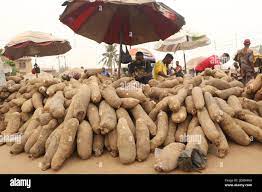
Back in 2017, Chief Audu Ogbe as Minister of Agriculture and Rural Development, on June 29, 2017, kick started Nigeria’s
yam export project with 72 metric tonnes of yam export to Europe and America.
For him, “there is no reason to be anxious about what the new initiative of the federal government on yam export portended for the populace”. He specifically said “those who are apprehensive about possible non-availability of yams for local consumption as a result of yam export need not be”.
The argument of the agric ministry: ‘Nigeria has consistently been reckoned globally as the largest producer of yams, at various times, accounting for between 65 and 76 per cent of the world production.
A report by Factfish, a research agency, disclosed that, in 2014, an estimated 45.0 million metric tonnes of yam was produced on 5.4 million hectares of farmlands at (8,309 kilogramme or) 8 metric tons per hectare. This was an increase over the 2013 figure estimated at 35.6 million metrics and 2012 production of 32.3 million metric tonnes, following annual production fluctuations ranging between 26 million metric tonnes and 37 million metrics from 2001 to 2011.
Ghana, by contrast, as the third largest producer in West Africa after Nigeria and Cote d’Ivoire, produces 11.2 per cent the world total, but accounts for over 94 per cent of total yam exports in West Africa, with about 90 per cent of its yams exported to the US, Canada, UK and other European countries…’
The summary of the ministry’s argument is that Nigeria is a big yam producer, World’s number one producer, post-harvest loss is endemic, and there is no shortage of yam for home consumption.
Stakeholders of the Export Advocacy Group reacted (abridged) as follows:
It is time to scale up production and it has to be deliberate, if we don’t export yam Ghana will help us to export our yams; then we will lose out either ways- that is, no foreign exchange and not enough yam for local consumption.
-Arnold Jack
According to the May 2017 report by the Nigeria Bureau of Statistics, 1kg of yam goes for N256. This means that 72 tonnes of yam would have a street value of N18 million. Do the maths. Forget that this is less than 50% of the volume of trade on a good day in Katsina Ala yam market every week. Anyway, the yam was well packed, and then freighted to the US and UK.
Let us assume that the packaging and freighting cost N3 million (and it might be a lot more, given that yam is heavy). So we have about N15 million net worth of yam (18 – 3 = 15). Assuming we sell it at twice the price, we would make a profit of N15 million. Again, let us assume that we did not incur additional cost in the transaction. So, here is the summary: we exported 72 tonnes of yam, and made N15 million. Good business, good profit.
Now this is where I am going with this: if 72 tonnes of yam is processed to pharmaceutical grade starch, (PGS) (that is the major component of tablets and capsules), we will get about 9.7 tonnes of pure PGS. I am a pharmacist, I know. Depending on your source, pharmaceutical grade starch goes for anywhere from $20 – 40/kg in the international market. And you can Google this up. Pa Audu’s 72 tonnes of yam is therefore worth a princely N102 million if it was processed to PGS (assuming it is sold for $30/kg, just to be conservative). So, N18 million worth of yam, processed to N102 million, profit of about 84 million.
The question is, has Pa Audu made N15 million or lost N84 million?
Imagine, for instance, that Benue State was interested in setting up a starch production plant in Katsina Ala. Would we need to export 72 tonnes of starch to make N15 million, instead of making N84 million? And this is a state that makes a pitiable Internally Generated Revenue of N250 million per month. The same Benue produces arguably half of the oranges in the country but there is no single fruit juice making industry in the state. This is not about Benue.
Interestingly, cost of yam today has hit the roof. A sizeable tuber of yam which sold for between N700 and N800 in August 2021 in Lagos now sells for between N200 and N2200. Why? Logistics. According to yam vendors, it costs N500 to transport a tuber of yam from the North to the South; the production of yam in the Southwest is at low ebb. Most tubers of yam are transported from the North, South-South and South-East.
Siaka Momoh, Publisher/editor, The Real Sector; www.realsectornow.com;


